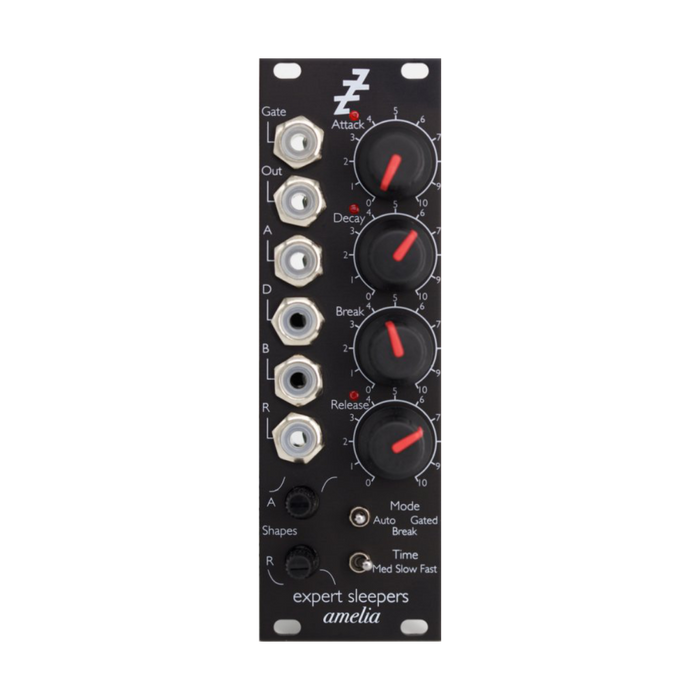
Expert Sleepers Amelia
Format: Eurorack
Width: 8HP
Depth: 42mm
Current: 33mA @ + 12V, 33mA @ -12V

Format: Eurorack
Width: 8HP
Depth: 42mm
Current: 33mA @ + 12V, 33mA @ -12V
Amelia isADBRMore(Attack/Decay/Break/Release) is an unusual envelope/function generator.Each envelope time parameter and break level can be controlled by CV, and if the envelope is set to 'auto trigger', it can also be used as a complex VCLFO.
Attack, Decay and Release shapes can be independently and continuously adjusted from exponential to linear to logarithmic.
Amelia was developed specifically for use with sequencers.Complex and flexible envelope shapes can be created from simple trigger-only signals with no adjustable gate length and modulated with voltage control.
A module consists entirely of analog components and discrete logic. No 'microcontroller' or 'digital-to-analog conversion' is used, so voltage levels and response times are never quantized.
The exact behavior depends on the mode switch, but is broadly the same in all modes.
Each CV input of Attack / Decay / Release has a voltage range of 10V corresponding to the full range of the knob.Break level CVThe input is used directly (break occurs when the output envelope exceeds the voltage of the input).In either case, the knob and CV values are simply summed, and the negative CV can also be entered.
In this mode, a pulse to the Gate input will trigger the envelope.The image below shows the input trigger/gate in green and the output envelope in yellow.
When triggered, the envelope will rise until it reaches its maximum value (8V) for the time set by the Attack knob (and CV).then at the time set by the Decay knob (and CV)breakDescend until level is reached (Break control is Time notLevelis).The envelope will then drop and stop until it reaches 0V for the time set by the Release knob (and CV).

The envelope will always rise to its maximum level even if the input trigger is shorter than desired.
The envelope can be re-triggered during the Decay and Release stages.In that case, there is no reset to 0V associated with the trigger, and it starts rising again from its current level to its maximum level.

Since the 'break level' defines when the envelope switches from decay to release, setting the break level to maximum will result in only a release without a decay stage, similarly setting the break level to minimum will result in a release stage. There is no decay, only decay.So if you want a simple two-stage AD envelope, set the Break control to either extreme, and Amelia does just that.

This mode differs from 'Break mode' only in that it transitions from decay to release when the input trigger signal goes from high to low. In 'Gated mode' the Break level control has no effect, but the length of the input trigger (gate) becomes important.

In this mode, you can get something like a sustain stage by setting the decay time significantly longer.As long as you press the keyboard, the sound gradually fades out, but when you release it, the sound stops (decays faster), creating an envelope shaped like a piano.

The envelope in this mode behaves like a free-running LFO that automatically re-triggers and cycles when it reaches 0V at the end of the release stage. Break level works similarly to 'Break mode'.You can also use the Gate input to re-trigger the envelope in-cycle.

The 'Time' switch hasMed(ium) / Slow / Fast There are three settings for When Fast is selected, each stage of Envelope ˚ can be adjusted in approximately 3 millisecond to 1 second. Medium is about 1/1 this speed, and Slow is another 6/1 speed.
A small knob labeled 'A' at the bottom of the module sets the shape of the attack stage.At the middle position of the knob the attack is a simple linear rising ramp, and when turned counterclockwise it becomes an exponential attack with a gradual rise and then steepening.Turning it clockwise will result in a logarithmic envelope that rises quickly and then slows down.

The knob below labeled 'R' sets the shape of both the Decay and Release stages, similar to the 'A' knob.

Note that the classic analog ADSR envelope generator has logarithmic attack and exponential decay/release.

Also, setting each Shape knob to extreme positions when using long envelope times (within the range) can produce unexpected results.If necessary, you can set the 'Time' switch to the next slow setting and adjust the knob value to get the desired time and shape.